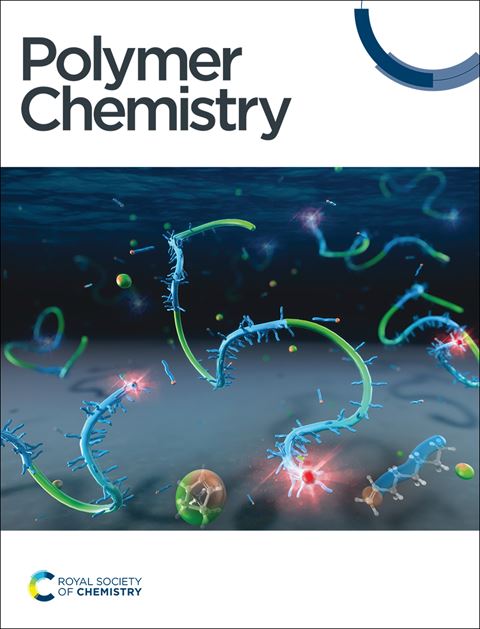Pulsed laser polymerization to retrieve kinetic parameters for a propagated mid-chain radical in poly(n-butyl acrylate) synthesis: a combined DFT and kinetic Monte Carlo study
IF 3.9
2区 化学
Q2 POLYMER SCIENCE
引用次数: 0
Abstract
Radical polymerization of n-butyl acrylate is characterized by backbiting of end-chain radicals (ECRs), with a propagation rate coefficient kp,e, into mid-chain radicals (MCRs), with a propagation rate coefficient kp,m. In pulsed laser polymerization (PLP) kinetic studies, it is currently assumed that a MCR becomes a (fully developed) ECR after one propagation step. Here we demonstrate that a more gradual transition likely takes place, introducing a propagated mid-chain radical (PMR) with a propagation rate coefficient kp,P or equivalently a transition propagation factor γ that at least theoretically can very between 0 (kp,P=kp,m) and 1 (kp,P=kp,e). Kinetic Monte Carlo (kMC) simulations under free radical polymerization (FRP) conditions hint at a γ not too close to 0 (e.g. not below 0.01), and Density functional theory (DFT) calculations at a γ not too close to 1 (e.g. not above 0.8). It is further shown that the ratio of the peak heights in a PLP – size exclusion chromatography (PLP-SEC) spectrum is sensitive to a variation in γ. This opens the door to the future experimental determination of kp,P considering different frequencies, provided that the initiator radical generation is well-described. At 325 K and using 500 Hz literature data, we currently put forward a γ of 0.1. In addition, the PMR backbiting potential is evaluated, introducing a backbiting scaling factor ẟ with respect to the conventional ECR backbiting rate coefficient (kbb). It is showcased that this extra backbiting contributes to a better understanding of the migration mechanism and short branch formation in acrylate radical polymerization, although the experimental determination of ẟ is less straightforward. Overall the current work highlights how acrylate-specific rate coefficients can be obtained in a roadmap format, considering higher and lower frequencies, and lower and higher temperatures.脉冲激光聚合以获取聚丙烯酸正丁酯合成中传播的中链自由基的动力学参数:DFT和动力学蒙特卡罗研究的结合
丙烯酸正丁酯自由基聚合的特点是端链自由基(ecr)的增殖速率系数为kp,e,而中链自由基(mcr)的增殖速率系数为kp,m。在脉冲激光聚合(PLP)动力学研究中,目前假设MCR在一个传播步骤后成为(完全发展的)ECR。在这里,我们证明了一个更渐进的转变可能发生,引入一个传播的中链自由基(PMR),其传播速率系数kp,P或等效的转移传播因子γ,至少在理论上可以非常介于0 (kp,P=kp,m)和1 (kp,P=kp,e)之间。自由基聚合(FRP)条件下的动力学蒙特卡罗(kMC)模拟表明,γ不太接近于0(例如不低于0.01),密度泛函理论(DFT)计算表明,γ不太接近于1(例如不高于0.8)。进一步表明,在PLP-尺寸排除色谱(PLP- sec)光谱的峰高比是敏感的变化,在γ。这为未来实验确定考虑不同频率的kp,P打开了大门,前提是引发剂自由基的产生得到了很好的描述。在325 K下,使用500 Hz文献数据,我们目前提出了0.1的γ。此外,还评估了PMR的诽谤潜力,引入了一个与传统ECR诽谤率系数(kbb)相关的诽谤比例因子ẟ。研究表明,这种额外的诽谤有助于更好地理解丙烯酸酯自由基聚合中的迁移机制和短分支形成,尽管ẟ的实验测定不太直接。总的来说,目前的工作重点是如何以路线图格式获得丙烯酸酯特定速率系数,考虑更高和更低的频率,以及更低和更高的温度。
本文章由计算机程序翻译,如有差异,请以英文原文为准。
求助全文
约1分钟内获得全文
求助全文
来源期刊

Polymer Chemistry
POLYMER SCIENCE-
CiteScore
8.60
自引率
8.70%
发文量
535
审稿时长
1.7 months
期刊介绍:
Polymer Chemistry welcomes submissions in all areas of polymer science that have a strong focus on macromolecular chemistry. Manuscripts may cover a broad range of fields, yet no direct application focus is required.
 求助内容:
求助内容: 应助结果提醒方式:
应助结果提醒方式:


